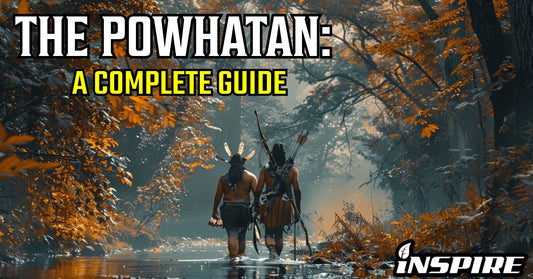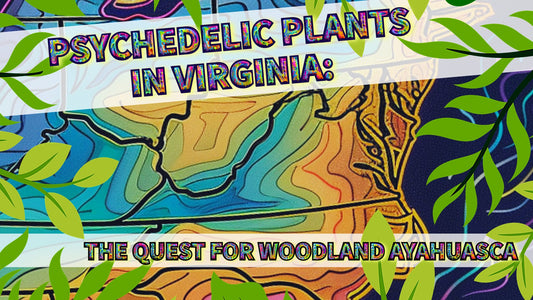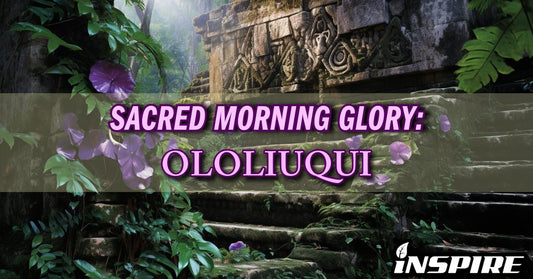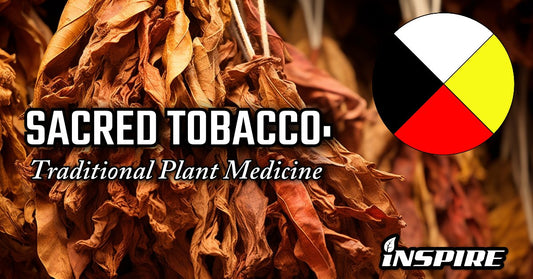Written By: Zach Champ
Connect with me on Instagram!
**Read our other article about NATIVE AMERICAN HISTORY IN VIRGINIA

WHO WERE THE POWHATAN?
The Powhatan were a confederation of Algonquian-speaking Native American tribes who occupied the eastern part of Virginia. This area, known as tidewater Virginia, encompasses the coastal regions near the Chesapeake Bay and extends into southern Maryland.
The Powhatan Confederacy, formed shortly before the Jamestown settlement in 1607. They were a powerful alliance of over 30 tribes. Its creation was driven by a need to protect against other tribal threats, particularly the Iroquois Confederacy to the north.

At the head of this confederacy stood Chief Powhatan, who inherited six tribes and later expanded his influence to create a formidable domain that stretched across nearly all of tidewater Virginia.
The Powhatan language, known as Virginia Algonquian, is noteworthy for having contributed words to the English language. Common terms like moccasin and tomahawk have their origins in the Powhatan language.
Pocahontas
Perhaps the most famous figure in the history of the Powhatan Confederacy is Pocahontas. Born around 1595, Pocahontas was the daughter of Chief Powhatan.

"Pocahontas" was a nickname given to her by her father, meaning "mischievous one." Her real name was Amonute and Matoaka, which means "flower between two streams".

Pocahontas became involved in events with Captain John Smith and John Rolfe when European settlers arrived on Powhatan land to establish the colony of Jamestown.

Pocahontas was sent to negotiate for the release of Powhatan prisoners, and according to John Smith, he released them for and to Pocahontas alone.

Despite her early ties with the English, Pocahontas died in England at the young age of 21, far from her homeland and her people.

WHERE DID THEY LIVE?
The earliest native peoples to inhabit what is now Virginia arrived shortly after the end of the last ice age, around 15,000 to 10,000 years ago. People came into Virginia from both the North and from the West chasing herds of large Pleistocene game animals such as mammoth, while glaciers and ice sheets receded across the continent.

By the time European colonists arrived, the Powhatan Confederacy had established control over a substantial territory, encompassing the tidewater area from the south side of the James River to the Potomac River and parts of the Eastern Shore.

Captain John Smith's map of Virginia, published in 1612, provides a detailed view of the Powhatan Confederacy's domain. Smith's map not only depicted the geographical features of the region but also identified numerous American Indian towns.

The Powhatan referred to their territory as Tsennacommacah, meaning "This densely populated land."
Powhatan settlements were typically located along rivers and streams, with the Chesapeake Bay forming a central hub. Towns and villages often had strategic locations for farming, fishing, and hunting.

The Powhatan Indian lands encompassed all the Tidewater Virginia area, from the south side of the James River north to the Potomac River, and parts of the Eastern Shore. Its span was approximately 100 miles by 100 miles.
Powhatan settlements were typically located along rivers and streams, with the Chesapeake Bay forming a central hub. Towns and villages often had strategic locations for farming, fishing, and hunting.

SOME NOTABLE POWHATAN TOWNS INCLUDED:

-
OCCAHANNOCK- This town was situated three miles west of Exmore in Accomack County, on the Eastern Shore. Its location provided direct access to the Chesapeake Bay and its rich marine resources.

-
ACCOMAC- The tribe of Accomac was based at the head of King's Creek, also in Accomack County. The name Accomac translates to "across the water," reflecting the tribe's proximity to the bay and its dependence on maritime resources.


-
CHESAPEAKE- The word Chesapeake means “Big Salt Bay”. The Chesapeake were a tribe that inhabited the area near modern-day Chesapeake City. However, the tribe was exterminated shortly after the establishment of the Jamestown Colony due to conflicts with European settlers.

-
NANSEMOND- Located near Reid's Ferry in Suffolk, the Nansemond tribe lived along the river bearing the same name. Their territory offered a rich mix of forest and marshland, providing ample resources for hunting, fishing, and agriculture.

-
WARRASKOYACK- This town was located on the Pagan River near Smithfield. Like many other Powhatan towns, it was strategically positioned along a waterway, which facilitated fishing and transportation.


-
QUIYOUGHCOHANNOCK- Located along the James River, this town was known for its close interactions with English colonists, particularly during the early years of the Jamestown settlement.

-
WEYANOCK- Also known as Weyanoke, this tribe resided in modern-day Charles City County. Their territory extended along the James River, providing access to abundant resources.
-
APPAMATUCK- Situated along the lower Appomattox River, in what is now Petersburg, Colonial Heights, and parts of Chesterfield and Dinwiddie Counties, the Appamattuck tribe played a key role in Powhatan's domain.

The tribe was led by a werowansqua named Opossunoquonuske at the time of John Smith's capture by the Powhatan.
-
ARROHATECK- The Arrohateck, or Arrohattoc, tribe inhabited Henrico County, Virginia, in the early 18th century. Their main village was located on the James River, the location of which is now the site of Henrico, Virginia.
In the early 18th century, the tribe was led by their chief Ashuaquid and was part of the Powhatan Confederacy. The Arrohateck also had another village, which was ruled over by Powhatan's son Parahunt also known as Tanx (meaning "Little" Powhatan.)
In 1607, the Arrohateck tribe encountered Christopher Newport and John Smith, who were exploring the region with a group associated with the Virginia Company of London. The group was given a warm welcome by the Arrohattocs, a reception that they enjoyed when they continued up the James River.

-
CHICKAHOMINY- The Chickahominy ("The Coarse Ground Corn People") were an independent Algonquian-speaking tribe that occupied the Tidewater area along the Chickahominy River near its start at the James River towards present-day New Kent County, Virginia.

The Chickahominy were known for their council of elders and religious leaders, known as mungai, who held significant influence over tribal affairs.

-
PASPAHEGH- The Paspahegh tribe, whose name means "At the mouth of a stream," inhabited the area west of the Chickahominy River's mouth in what is now Charles City and James City counties, Virginia. As a tributary to the Powhatan paramount chiefdom, they were integrated into the chiefdom around 1596 or 1597.
-
KECOUGHTAN- In the seventeenth century, Kecoughtan was a significant settlement that eventually became known as Hampton, Virginia. In the early twentieth century, it was also the name of a town nearby in Elizabeth City County. It was annexed into the City of Newport News in 1927.
Chief Powhatan had slain the weroance at Kecoughtan in 1597, appointing his own young son Pochins as successor there, while resettling some of the tribe at the Piankatank River.
Powhatan annihilated the inhabitants at Piankatank in 1608.
-
YOUGHTANUND- The Youghtanund, also known as the Manskin Indians, occupied a territory along the upper Pamunkey River in what is now King William County, Virginia. Their name is derived from the Algonquian word Manaskunt. The tribe resided in a two-mile stretch of the Pamunkey River, close to the present-day location where Route 360 crosses the river. The Youghtanund, Manskin, and Pamunkey were all sister tribes.

The Manskin were ruled by Chief Powhatan’s brother, Opechancanough.
After 1750, the Manskin Indians disappeared as a tribe from the historical record. The reasons for their disappearance remain unclear, but it likely involved a combination of factors, including conflicts with European settlers, diseases brought by the colonizers, and displacement from their traditional lands.

-
PAMUNKY- The Pamunkey Indian Tribe, known for its powerful status within the Powhatan Confederacy, had several capital towns near the mouth of the Pamunkey River. Recognized by the Commonwealth of Virginia and federally in January 2016, the Pamunkey Tribe holds a significant place in Virginia's history.

Cockacoeske, the weroansqua of the Pamunkey, became a notable figure after succeeding her husband, who was killed fighting for the English.

Known to the English as "Queen of the Pamunkey," she allied with Governor Berkeley against Bacon's Rebellion, and signed treaties which brought peace between the warring groups, highlighting the tribe's political influence and strategic alliances during this time.
-
MATTAPONI- The Mattaponi tribe, whose name translates to "landing place," holds a significant historical and cultural presence in Virginia. They are one of only two Virginia Indian tribes in the Commonwealth that possess reservation land, a territory they have maintained since the colonial era.

Considered a branch of the Pamunkey Indians, who are also federally recognized, the Mattaponi tribe resides primarily in King William County on their reservation.

Situated along the borders of the Mattaponi River near West Point, Virginia, this reservation serves as a vital center for the tribe's cultural preservation and community life.
-
PIANKATANK- The Piankatank tribe derived its name from the river they inhabited, meaning "winding waterway." The Piankatank River is a 24.4-mile-long river in the U.S. state of Virginia. Located on the Middle Peninsula, between the Rappahannock and York rivers.

The Piankatank were part of the Nanzatico (Nantaughtacund) group of Native Americans.
-
PISCATAWAY- While primarily located in present-day Maryland, the Piscataway tribe had ties to the Powhatan Confederacy. Their territory extended along the Potomac River, providing a strategic position at the confederacy's northern border.

-
NANZATICO- The Nanzatico, also known as Nantaughtacund, were a Native American tribe situated on both sides of the Rappahannock River in present-day Caroline and King George counties.
Their presence is evidenced by the recorded towns of Nanzemond, Warisquock, and Ausaticon in the mid-17th century. The tribe's territory extended across the river from the Rappahannock Tribe and village, highlighting their strategic location and interactions with neighboring indigenous groups.

Despite their existence and land ownership, the Nanzatico faced significant challenges, including the colonization efforts of European settlers.
By 1662, the tribe's werowance, Attamahune, signed a deed for a land sale.
The Nanzatico (Nantaughtacund) lived across the river from the Rappahannock Tribe and village, until 1705 when the colonists deported the Nanzatico as slaves to the West Indies.

-
RAPPAHANNOCK- The Rappahannock are a federally recognized tribe in Virginia and one of the eleven state-recognized tribes.
In 1607, the Rappahannock were the dominant tribe of the Rappahannock River valley, maintaining thirteen villages along the north and south banks of the river named after them.

The Rappahannock maintained two capital towns, one near Neals Point and another near modern Tappahannock (known as Topahanocke) which served as their capital.

The werowance, or chief, of the Rappahannock tribe was described as being adorned in ceremonial attire, with his body painted crimson and his face adorned with blue and silver. He wore a distinctive red deer-hair crown and carried a copper plate while playing a flute, symbolizing his authority and status within the tribe.
In 1608 Smith returned to the Rappahannock and mediated a feud between them and their neighbors, the Moraughticund (Morattico Indians).

-
MORATTICO- Morattico is an unincorporated town along the Rappahannock River in Lancaster County, Virginia, United States. It sits across Mulberry Creek from Belle Isle State Park.
Morattico is an anglicized version of Moraughtacund, the name of a Native American tribe whose primary village may have been on or near this site.

The Moraughtacunds and their site were discovered by Captain John Smith in 1608.
He would mediate a feud between the Moraughtacunds and their neighbors, the Rappahannock tribe. The Moraughtacund tribe moved further west by 1650.
-
WICOCOMICO- The Wicocomico were an Algonquian-speaking tribe who lived in Northumberland County, Virginia, at the head and slightly north of the Little Wicomico River.

They were the first Native people on the mainland to encounter Captain John Smith, before his famous interaction with Pamunkey and Pocahontas of the Powhatan people.
-
SEKACOWANE / COAN- Coan is an unincorporated community in Northumberland County, in the U.S. state of Virginia. This area was home to a tribe known as the Chickacone Tribe or the Sekacawone (Coan).
The Sekacawone village was located upriver from Wicocomico and consisted of only 30 warriors and their families. They would eventually merge with the Wicocomico and references to them would disappear from the historical record shortly thereafter.
-
NOMINI- Nomini, located on the western side of Nomini Bay, derives its name from the Algonquin word Onawmanient, meaning “deep current”.

In June of 1608, Captain John Smith was ambushed by the Indians near Nomini under the orders of Chief Powhatan.

-
PATAWOMECK / POTOMAC- The Patawomeck, also known as the Potomac tribe, inhabited a region north of Accokeek Creek in Stafford, Virginia. Recognized as a state-recognized tribe in Virginia, they trace their lineage back to the Patawomeck people.
The Patawomeck primarily focused on corn farming, cultivating a significant area of land close to 1,000 acres in size annually, with their main town situated north of Potomac Creek in present-day Stafford County.
The leadership structure of the Patawomeck included a werowance, known as Japazeus (also spelled Japazaws or Iopassus).
Japazaws led the Patawomeck from his satellite village Passapatanzy.

-
WEROWOCOMOCO- Located on the north bank of the York River, Werowocomoco served as the principal town and headquarters of Chief Powhatan.

It was from this location that Chief Powhatan exerted his authority over the confederacy. The site was also significant for its role in the early interactions with European settlers, including Captain John Smith and the Jamestown colonists.

DAILY LIFE
The climate of Virginia during the Powhatan's time was cooler, with more intense winters, vibrant springs, hot and humid summers, and brisk falls.
The Powhatan were semi-nomadic, with permanent villages and seasonal fishing and farming camps. Hunting camps were also set up for extended expeditions.

The Powhatan's environment was rich in resources, with lush forests that provided raw materials for tools and canoes.
Canoes were an essential part of Powhatan daily life, used extensively for fishing and travel.

The Powhatan were also highly superstitious about water; they avoided swimming or canoeing at night, believing it to be bad luck.

FOOD
Seasonal cycle / Seasonal Wheel
The Eastern Woodlands of Virginia offered a variety of plants and animals, which the Powhatan utilized for food. The humid subtropical climate, with its ample rainfall, allowed for a diverse ecosystem.
Due to the unique ecosystem of the Eastern Woodlands, different types of food were available at different times of the year.

The Powhatan followed a seasonal pattern, moving between winter villages and summer towns. The majority of the Powhatan diet consisted of fish with other gathered / gardened crops.
Men primarily focused on hunting and fishing, while Women were primarily responsible for tending the crops.
The most important crops cultivated were the Three Sisters: corn, beans, and squash.

The Powhatan used a special inter-cropping technique that was a sustainable practice that promoted soil health and increased crop yields. The corn provided a natural trellis for the beans, which in turn fixed nitrogen in the soil, while the squash spread along the ground, reducing weed growth and preserving soil moisture.

In addition to these staple crops, the Powhatan also grew passionflower, which served as a nutritious food source full of fiber.
The Powhatan supplemented their agriculture with a wide variety of gathered and foraged foods. This included wild herbs, berries, nuts, and edible plants found throughout the forests and marshlands. Foraging was typically done by women and children, who were well-versed in the identification and use of local plants.

Acorns, (a common staple in the Eastern Woodlands), were processed to remove tannins and ground into meal for baking bread or thickening soups.

Berries such as blueberries and strawberries were eaten fresh or dried for later use. Wild herbs and roots were gathered for both culinary and medicinal purposes.


Fishing
Fishing was a spring and summer activity for the Powhatan Indians, who ate fish, berries, and stored nuts during this time. When other food resources were low, they would gather clams and oysters.

The Powhatan had a diverse diet of aquatic life. Commonly caught fish included sturgeon, catfish, mullet, and perch. In addition, the Powhatan harvested shellfish like oysters, clams, and mussels and crabs from the Chesapeake Bay and its tributaries.

The Powhatan made large elaborate canoes which they used extensively for fishing and travel.
The largest canoes were about 4 feet deep and 50 ft long and were propelled by the use of paddles and oars.

Fishing techniques included:
-
Rods, line, and bone fishhooks: Used for fishing
-
Javelins: Used to spear fish in shallow water
-
Nooses: Used to catch Atlantic sturgeon while they were asleep on the water's surface
- Small fires: Set in canoe hearths to attract fish to the surface with bright lights so they could be speared
-
Weirs and V-Shaped Dams: Made of rocks and reeds to create fences in a maze-like pattern. These structures were set up to trap fish by funneling them into a net or trap which was set up downstream.
- Basket traps: The Powhatan made baskets and fishnets from deer sinew, bark, and hemp cordage made by the Women with the use of their hands and thighs.
Fish were also hunted with the use of bows and arrows with rope tied to them to lure the fish in.

The importance of Hunting
Hunting was a cornerstone of Powhatan culture, providing both food and materials for clothing and tools. As a result, Powhatan hunters were extremely skilled and talented and had sophisticated weapons.

The traditional Indian longbow was the weapon of choice for Powhatan hunters.
Made from native woods such as ash or hickory, these bows were powerful enough to shoot arrows up to 40 yards and could penetrate English wooden shields (stronger than English pistols at the time!).
Hunters used stone arrowheads, crafted with precision, to ensure effective kills.
Powhatan hunters would use wrist guards, specially constructed quivers, and sighting tools to increase the accuracy and rate of fire so that they could shoot more arrows, faster.

Powhatan hunters were known for their stealth and precision. They often used camouflage and natural cover to approach their game undetected.

MEDICINE
The Powhatan employed a variety of traditional herbal remedies, using bark, leaves, and roots from a wide range of plants. They often categorized plants based on the body part or symptoms being treated.

Herbal remedies used by the Powhatan included Honeysuckle, Indian Pipe, and Queen Anne’s Lace; as well as the use of the roots of flowering Dogwood, Red Puccoon, and Eastern Black Walnut for treating illnesses, especially with the use of poultices.

Powhatan healers would often use a variety of techniques to cure and ail injuries and diseases. Shamans, who acted as healers, approached patients in a trance, chanting and singing to drive out illness.
Powhatan healers practiced techniques such as cupping to draw liquids out of the body, as well as lancing with pointed reeds to treat injuries.

The Powhatan, like other tribes, would use specially constructed sweat lodges for religious, ceremonial, and healing purposes.
They also would practice cauterization for treating snake bites and open wounds to prevent infection and to promote healing.
Despite the strength and health of the Powhatan people, they suffered greatly from diseases introduced by European colonists. These new illnesses, to which they had no immunity, caused widespread sickness and death.

NATIVE VILLAGES AND HOUSING
Powhatan villages were typically located in cleared areas of deciduous forests along a river or stream, with cultivated fields nearby and mixed forests beyond.
Villages were typically surrounded by palisades for protection, with cultivated fields nearby for agriculture.

One example of a palisaded Powhatan community includes the village of Patawomeck located near modern-day Fredericksburg Virginia.
The Powhatan would clear fields by felling, girdling, or firing trees at the base and then setting fire to the slash and stumps.
Powhatan called their houses Yi-Hakan and they were made from natural materials found in the surrounding environment. The frame of a Yi-Hakan consisted of saplings of native trees such as red maples, locusts and red cedar.

Powhatan houses were framed structures made of wooden poles and woven thatched mats for siding/insulation/exterior.
These houses often featured beds built into the walls, consisting of raised platforms. Beds were furnished with either animal furs or blankets, and had pillows made from local plants woven together.

In addition to houses, the Powhatan would also build storage sheds and drying racks for firewood and corn. Some villages would have communal buildings which were used for feasts, dances, and certain religious ceremonies.
Chief Powhatan was a strict leader and demanded heavy tribute from the tribes he conquered and integrated into the larger confederacy. Tribute was often made in the form of corn and deer hide.

Because Powhatan demanded so many tributes, the Powhatan had actually over-hunted the deer population in their territory.
As a result, they were forced to travel to the edge of their borders into other neighboring tribes' hunting grounds. This poaching of game angered neighboring tribes such as the Siouan-speaking Monacan and resulted in inter-tribal warfare.

MATERIAL CULTURE
The Powhatan were skilled in crafting tools from a variety of natural materials.
Stone, bone, and wood were commonly used to create essential items for hunting, fishing, and agriculture.

They made sewing needles from bone, fishing hooks, arrowheads, gardening hoes, as well as wooden utensils like spoons, gourds, and ladles.


There have even been ornate decorated cups made of turtle shells and ceremonial ceramic smoking pipes adorned with copper and shark's teeth found at Powhatan archeological sites!

The Powhatan created pottery using locally sourced clay. Pottery often had stamped designs created using fabrics and textiles. These ceramic items were used for cooking, storage, and ceremonial purposes.

The Powhatan also utilized stone pestles and mortars.

Textiles played a significant role in Powhatan society. Women were primarily responsible for weaving, using materials such as native grasses, reeds, and tree bark.

They created mats, blankets, and clothing from these natural fibers, showcasing intricate designs and patterns. The Powhatan were famous for their high-quality mats, which were used for bedding, insulation, and even as walls for their homes.
The Powhatan were known to create small bridges for crossing rivers. These bridges were made of rope and planks of wood and lacked hand-rails.

RELIGION & SPIRITUALITY
The Powhatan worshiped multiple gods and spirits, and because of this the English referred to their religion as “Devil Worship”.
The reality was that the Powhatan had a complex spiritual tradition which centered around the belief in two major gods: Ahone, the creator and giver of good things, and Okeus/Quioccos, the evil spirit.

Ahone, the creator god, was considered the giver of all good things. He was seen as a benevolent deity responsible for creation and harmony in the world. The Powhatan believed that Ahone had crafted the land, animals, and people, bestowing blessings and ensuring balance in nature. While Ahone's influence was omnipresent, he was generally considered a distant and non-interventionist god, not requiring elaborate offerings or rituals.

In contrast to Ahone's benevolence, Okeus (also known as Quioccos or Okee) was the god of misfortune, disease, and crop failure. Okeus was a more demanding and vengeful spirit, requiring regular offerings and rituals to appease his wrath. The Powhatan believed that Okeus could bring suffering and chaos if he was not properly respected, so they offered tobacco, beads, and food to placate him. These offerings were made at temples and sacred sites to ensure community well-being.

The Powhatan also believed in other supernatural entities, such as the Great Hare, a spirit associated with fertility and renewal.
The Powhatan's religious leaders, called Quioquisock or shamans, communicated with the supernatural, interpreted messages, presided over religious rituals, and maintained temples. They also worked closely with rulers to make decisions about tribal leadership.

Medicine Men performed rituals and ceremonies in a language which the normal people didn’t recognize, probably an older or original dialect of Algonquin, the main language that Powhatan language derives from.
The Powhatan tracked time through lunar months and observed a seasonal cycle that influenced their spiritual practices. Rituals and ceremonies were held to mark significant events, such as the changing seasons and agricultural milestones.
These celebrations often involved feasts, dances, and offerings to the gods.

The Powhatan kept detailed calendars known as Sag Ko Ko Quejacasong meaning “Memory of the Gods”.

A WARRIOR SOCIETY
The Powhatan had a warrior society with a strong leadership structure.
Tribal leaders were known as Weroances for men and Werowansqua for women, meaning "commander/queen."

CHIEF POWHATAN
Chief Powhatan's given name was Wahunsonacock, but he was also known as Wahunsenacawh.

Captain John Smith described Chief Powhatan as a tall, well-proportioned man with gray hair and a strong body. Smith also said that people obeyed Chief Powhatan with great fear and adoration.
Chief Powhatan is believed to have had at least 20 children, but the genders and names of the children are all unknown except for one. His only known daughter was Pocahontas, who married the English settler John Rolfe of the Jamestown Colony.

HUSKANAW- THE COMING OF AGE CEREMONY
“Make them dark people”
The Huskanaw was held every 10-15 years for the whole chiefdom, although individual tribes would occasionally hold their own similar ceremonies yearly. It was a coming-of-age ceremony where young men would become initiated into adulthood and become fully recognized men within Powhatan society.

This ceremony would start in the morning with a large dance and ceremonial feast between all the participating tribes. Two separate groups of dancers were made around two separate fires. One group would go clockwise while the other would go counter-clockwise. Each group was led by a Weroance and would dance vigorously, and if anyone participating grew tired or weak they would be beaten with sticks by Shamans.

Outside the dancers was a group of masked medicine men who wore deer horns on their heads and who would occasionally scream and make frightening noises at the dancers. They would also shake trees and rip bark off with their bare hands to intimidate the younger dancers who were about to undergo the initiation.
The young men to be initiated were forced into large hand-made wooden cages by the shamans. The shamans would then proceed to beat on the cages and stab the men with sticks to scare and frighten the young dancers.

During their time in the cages (which would last several days) they were only fed a concoction made of Datura which would cause them to hallucinate and become disoriented with amnesia.
The goal of this ceremony was to make the young dancers "forget their childhood" so they could emerge from the Huskanaw renewed as men ready to be warriors.

The Use of Datura (Read our blog on Datura!)
The purpose of this violent and strange coming of age ceremony was simple: Chief Powhatan's iron grasp rule over the tidewater region had forced him into decades of conflict with their surrounding native neighbors long prior to the arrival of the Europeans.
By necessity, Powhatan society had to cultivate an intimidating and formidable warrior culture!

WAR AMONGST NEIGHBORS
MONACAN (SIOUAN SPEAKING TRIBES)
The Monacan, speakers of a Siouan language, were both rivals and trading partners with the Powhatan Confederacy upon the arrival of English colonists in 1607.

Originating from the Ohio River valley, they migrated across the Allegheny Mountains approximately 4,000 years ago, settling in present-day Virginia.
The name Monacan may derive from the Siouan word mani, meaning "water," reflecting their close connection to the region's rivers and waterways.

CONFLICT AND COEXISTENCE
In 1608, Captain John Smith's encounters with the Monacan escalated into hostilities near the falls of the Rappahannock River. It was here that Captain John Smith captured a Monacan warrior, named Amorolek, who had been wounded in the fight.

During interrogation, the captive Indian explained to the English how three native groups dominated the land: the Powhatans, Monacans and Manahoacs.

Interestingly enough, the Monacan warrior Amorolek stated that he was from Hassininga (located near modern day Fredericksburg!) and mentioned three other towns: Stegara, Tauxuntania, and Shakahonea. He had been captured while traveling to Mohaskahod, which was a hunting town.
The Monacan, along with neighboring tribes like the Manahoac, engaged in sporadic conflicts with the Powhatan Confederacy. These clashes reflected the complex web of alliances and rivalries among Virginia's indigenous peoples.

THE IMPACT OF EUROPEAN COLONIZATION
The arrival of European colonists in the early 17th century transformed the dynamics of indigenous warfare in Virginia. The Powhatan Confederacy enabled the various Indigenous tribes of the region to put aside their differences and live together in greater harmony.
However, this arrangement proved incapable of dealing with the biggest threat to Native Americans- the settlement of Europeans.

The Powhatan and English had an uneasy relationship for the first 40 years of Virginia settlement.
However, the constant expansion of the colonists who needed more agricultural land to support their growing population, led to the seizure of Powhatan lands.
This led to a decade-long conflict known as the Anglo-Powhatan war that redefined the destructive fate of native Tsennacommacah and the rise of the future colonies of Virginia.

THE DECLINE OF THE POWHATAN CONFEDERACY
The decline of the Powhatan Confederacy was marked by a series of conflicts and strategic failures that culminated in the subjugation of its member tribes under English colonial rule.

Opechancanough, a prominent leader (and the brother of Chief Powhatan), led a series of surprise attacks on the English settlements, killing around 300 out of the original 1,200 colonists as well as destroying buildings, equipment, and livestock. Despite these efforts, the relentless influx of English settlers presented insurmountable challenges to the Powhatan.

The death of Chief Powhatan and the capture of Opechancanough signaled the end of Powhatan resistance. The Anglo-Powhatan Wars (1610–1646) ultimately resulted in the dissolution of the Powhatan Confederacy and the subjugation of its member tribes under English colonial rule.
After the war, the Powhatan chiefs ruled under the authority of the English royal governor.

In 1644, when Opechancanough was nearly 100 years old, he ordered his warriors to fight again, and they killed almost 500 settlers. Opechancanough was captured, and his successor signed over legal land rights to the colonists.

Opechancanough's death, along with the 1644 attack, signified the end of the delicate balance of power the Powhatan and English maintained during the first three decades of their coexistence. His successor, Necotowance, signed a peace treaty that effectively dissolved the Powhatan Confederacy.

By 1646, the Powhatan Confederacy had been decimated, not just by warfare but from the infectious diseases, such as measles and smallpox newly introduced to North America by Europeans.
The Native Americans did not have any immunity to these, which had been endemic to Europe and Asia for centuries. At least 75 percent of the Powhatan people died from these diseases in the 17th century alone.

NATIVES AND THE ENGLISH
Intermarriage between English settlers and Powhatan people was common, with the most famous being Pocahontas and John Rolfe.

Their son was Thomas Rolfe, who has more than an estimated 100,000 descendants today.


Many of Virginia's First Families have both English and Virginia Algonquian ancestry.

NATIVES AND THE SLAVES
By the mid-17th century, the need for labor led to an influx of indentured servants and enslaved Africans. By 1700, enslaved Africans constituted a significant portion of the population. Some escaped slaves and indentured servants joined the Powhatan tribes.

Following Bacon's Rebellion in 1676, the colony began enslaving Native peoples, though the practice was officially abolished in 1691. Despite this, many Powhatans were held in servitude into the 18th century.

RACIAL SEGREGATION & THE “PAPER GENOCIDE”

After Virginia passed stringent racial segregation laws in the early 20th century, including the Racial Integrity Act of 1924, Walter Plecker, head of the Vital Statistics office, mandated that only the terms "white" or "colored" be used on official documents. This erased all traceable records of Virginia Indians. All state documents, including birth certificates, death certificates, marriage licenses, tax forms, and land deeds, thus bear no record of Virginia Indians.
Plecker oversaw the Vital Statistics office in the state for more than 30 years, beginning in the early 20th century, and took a personal interest in eliminating traces of Virginia Indians.

Plecker falsely believed that biracial and multiracial individuals were actually of African origin and that they were fraudulently attempting to claim their race to be Indian or white so as to receive social benefits.
Plecker believed that no true Virginia Indians remained due to years of intermarriage and conducted a campaign to reclassify all biracial and multiracial individuals as Black, an act that tribal members have since come to describe as "paper genocide."

During WWII, many Powhatans volunteered for military service, seeking recognition separate from the Black community.
In 1954, Powhatans were given partial legal recognition by the General Assembly through a law stating that people with one-fourth or more Indian ancestry and one-sixteenth or less African ancestry were to be recognized as tribal Indians.

THE POWHATAN TODAY
Today, there are 8 tribes that claim descent from those original Powhatan tribes, including two (Pamunkey and Mattaponi) that have reservations near the original Jamestown area.

The Pamunkey and Mattaponi are the only two peoples who have retained reservation lands from the 17th century.
The Pamunkey Indian Tribe was the first to gain federal recognition in 2016.
All state-recognized tribes, except for the Mattaponi Indian Nation and the Patawomeck Indian Tribe of Virginia, have since gained federal recognition.

BELOW ARE LINKS TO THE TRIBES AND THEIR WEBSITES:









REFERENCES & ADDITIONAL READING:
-
The Powhatan Indians of Virginia: Their Traditional Culture (Volume 193) (The Civilization of the American Indian Series) - by Helen C. Rountree (In my personal library, I purchased a copy from Riverby Books lol)
-
Pocahontas’s People: The Powhatan Indians of Virginia Through Four Centuries (Volume 196) (The Civilization of the American Indian Series) - by Helen C. Rountree
-
https://www.jyfmuseums.org/learn/research-and-collections/essays/who-were-the-powhatan-indians-and-how-did-they-live
-
https://www.nps.gov/jame/learn/historyculture/chronology-of-powhatan-indian-activity.htm
- https://www.nps.gov/people/powhatan.htm











